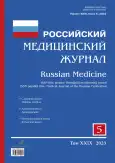Cosmetic results of wound treatment using the living skin equivalent in open tibial fractures
- 作者: Giandzhaliev R.A.1, Abdrakhmanov R.R.1, Ivashkin A.N.1, Abakirov M.D.1, Akhpashev A.A.1,2
-
隶属关系:
- Peoples’ Friendship University of Russia named after Patrice Lumumba
- Academy of Continuous Medical Education of Federal Scientific Clinical Center
- 期: 卷 29, 编号 5 (2023)
- 页面: 374-382
- 栏目: Original Research Articles
- URL: https://journals.rcsi.science/0869-2106/article/view/232004
- DOI: https://doi.org/10.17816/medjrf562880
- ID: 232004
如何引用文章
详细
BACKGROUND: Soft tissue wound treatment in open tibial fractures requires complex clinical approach. New cellular methods of wound treatment must be compared with the gold standard split-thickness skin grafting.
AIM: To compare the esthetic results of wound management with the living skin equivalent and skin grafting.
MATERIAL AND METHODS: A comparative study included 108 patients with open tibial fractures and soft tissue defects who underwent staged surgical treatment. In group 1 (n=51), the living skin equivalent was used, which is a bioengineered three-layer construction containing keratinocytes, fibroblasts, and collagen matrix. In group 2 (n=57), standard split-thickness skin grafting was used for wound repair. The surgery duration, complete epithelialization period, hospital stay, Vancouver Scar Scale (VSS) after 3, 6, and 12 months, and self-reported esthetic results 1 year after surgery were compared.
RESULTS: Living skin equivalent procedures were performed significantly faster than skin grafting (18.2±4.8 min vs. 35.5±14.8 min, р <0.001), and wound healing took longer (25.5±6.3 days vs. 19.6±4.7 days, р=0.035). The overall VSS score was significantly lower at all follow-up visits in group 1 than in group 2 (6.23±0.81 points vs. 8.12±0.98 points after 3 months, р <0.001; 5.17±1.18 points vs. 6.76±1.31 points after 6 months, р <0.001; 4.54±1.07 points vs. 5.09±0.65 points after 12 months, р=0.038). Moreover, 74.5 and 68.4% of the patients were satisfied with the appearance of the limb after treatment with living skin equivalent and skin grafting, respectively (р=0.023).
CONCLUSION: The cosmetic results of wound treatment in open tibial fractures with living skin equivalents are significantly better than those of split-thickness skin grafting.
作者简介
Ramin Giandzhaliev
Peoples’ Friendship University of Russia named after Patrice Lumumba
编辑信件的主要联系方式.
Email: dr_ramin@mail.ru
ORCID iD: 0000-0003-1427-1365
SPIN 代码: 5634-3140
candidate of the department
俄罗斯联邦, 6 Miklukho-Maklaya street, 117198 MoscowRinat Abdrakhmanov
Peoples’ Friendship University of Russia named after Patrice Lumumba
Email: rinat.abdr@gmail.com
ORCID iD: 0009-0009-4752-3531
SPIN 代码: 4606-6819
MD, Cand. Sci. (Med.)
俄罗斯联邦, 6 Miklukho-Maklaya street, 117198 MoscowAleksandr Ivashkin
Peoples’ Friendship University of Russia named after Patrice Lumumba
Email: doctor-alik@yandex.ru
ORCID iD: 0000-0001-5266-2418
SPIN 代码: 1968-9218
MD, Dr. Sci. (Med.)
俄罗斯联邦, 6 Miklukho-Maklaya street, 117198 MoscowMedetbek Abakirov
Peoples’ Friendship University of Russia named after Patrice Lumumba
Email: medetbek@mail.ru
ORCID iD: 0000-0002-5842-5904
SPIN 代码: 5099-0493
MD, Dr. Sci. (Med.)
俄罗斯联邦, 6 Miklukho-Maklaya street, 117198 MoscowAleksandr Akhpashev
Peoples’ Friendship University of Russia named after Patrice Lumumba; Academy of Continuous Medical Education of Federal Scientific Clinical Center
Email: akhpashev@yandex.ru
ORCID iD: 0000-0002-2938-5173
SPIN 代码: 9965-1828
MD, Cand. Sci. (Med.)
俄罗斯联邦, 6 Miklukho-Maklaya street, 117198 Moscow; Moscow参考
- Braza ME, Fahrenkopf MP. Split-thickness skin grafts. StatPearls. 2022. Available from: https://www.ncbi.nlm.nih.gov/books/NBK551561/
- Meleshina AV, Bystrova AS, Rogovaya OS, et al. Tissue-engineered skin constructs and the use of stem cells to create skin equivalents (review). Modern Technologies in Medicine. 2017;9(1):198–220. (In Russ). doi: 10.17691/stm2017.9.1.24
- Kulakova KV, Aleynik DYa, Charykova IN. Joint use of developed collagen-containing complexes and cell cultures in creating new tissue equivalents. Bulletin of Siberian Medicine. 2016;15(5):75–82. (In Russ). doi: 10.20538/1682-0363-2016-5-75-82
- Khan AA, Khan IM, Nguyen PP, et al. Skin graft techniques. Clin Podiatr Med Surg. 2020;37(4):821–835. doi: 10.1016/j.cpm.2020.07.007
- Rogovaya OS, Vasiliev AV, Kiselev IV, Terskikh VV. Use of human fibroblasts grown on microcarriers for formation of connective tissue equivalent. Russian Journal of Developmental Biology. 2004;(35): 76–79. doi: 10.1023/B:RUDO.0000022348.70630.6e
- Patent RUS N 106528 U1/29.12.2010. Byul. № 2010154049/14. Terskikh VV, Vasil’ev AV. Rogovaya OS, et al. Cellular implant for restoration of skin defects. Available from: https://patents.google.com/patent/RU106528U1/ru (In Russ).
- Ivashkin AN, Fominyh EM, Maksimenko VN, i dr. Primenenie zhivogo jekvivalenta kozhi v kompleksnom lechenii bol’nyh s troficheskimi jazvami nizhnih konechnostej venoznoj jetiologii. Military Medical Journal. 2009;330(11):51–52. (In Russ).
- Philandrianos C, Andrac-Meyer L, Mordon S, et al. Comparison of five dermal substitutes in full-thickness skin wound healing in a porcine model. Burns. 2012;38(6):820–829. doi: 10.1016/j.burns.2012.02.008
- Shahrokhi S, Arno A, Jeschke MG. The use of dermal substitutes in burn surgery: acute phase. Wound Repair Regen. 2014;22(1): 14–22. doi: 10.1111/wrr.12119
- Li MX, Ma J, Zheng ZJ, et al. Clinical effect of bi-layered artificial dermis and autologous skin graft in repairing bone and/or tendon exposed wounds. Zhonghua Shao Shang Za Zhi. 2020;36(3):179–186. (In Chinese). doi: 10.3760/cma.j.cn501120-20191119-00437
- Shang F, Lu YH, Gao J, Hou Q. Comparison of therapeutic effects between artificial dermis combined with autologous split-thickness skin grafting and autologous intermediate-thickness skin grafting alone in severely burned patients: a prospective randomised study. Int Wound J. 2021;18(1):24–31. doi: 10.1111/iwj.13518
- Serebrakian AT, Pickrell BB, Varon DE, et al. Meta-analysis and systematic review of skin graft donor-site dressings with future guidelines. Plast Reconstr Surg Glob Open. 2018;6(9):1928. doi: 10.1097/GOX.0000000000001928
- Krane NA, Mowery A, Azzi J, et al. Reconstructing forearm free flap donor sites using full-thickness skin grafts harvested from the ipsilateral arm. Otolaryngol Head Neck Surg. 2020;162(3):277–282. doi: 10.1177/0194599819901124
补充文件






